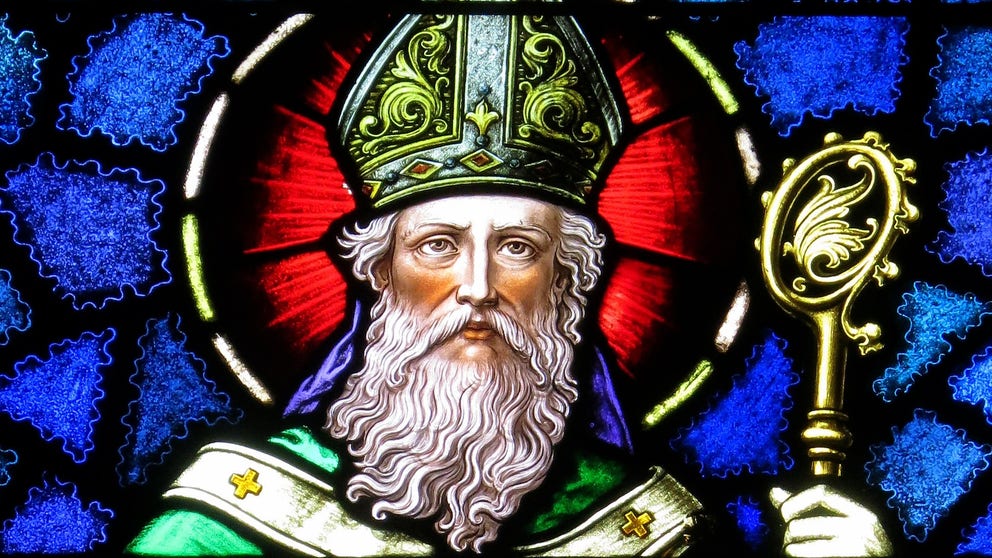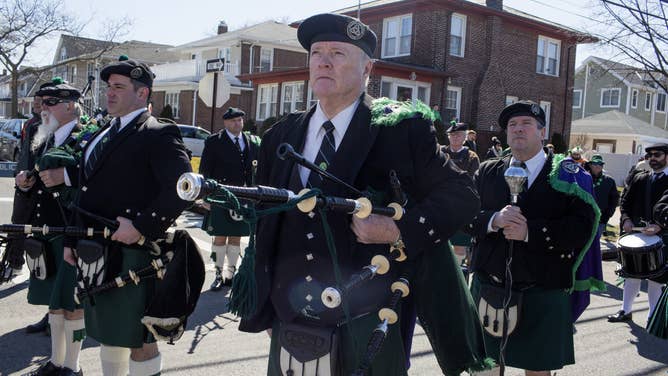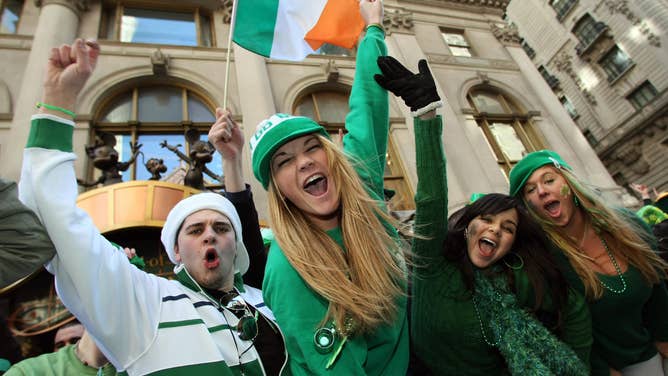The history of St. Patrick's Day
The history of St. Patrick's Day involves a slave who became a saint, solemn celebrations that became bombastic and a powerful showcase for the Irish people and Irish culture around the world.
How St. Patrick's Day became one of America's most popular holidays
How people celebrate St. Patrick's Day has continuously evolved throughout its more than 1500-year history.
Long before green rivers and bar crawls, St. Patrick’s Day was a holy occasion and one that morphed into a political movement for a new immigrant class in America.
"It's a funny thing, St. Patrick's Day — it has kind of evolved over time," said Elizabeth Stack, executive director of the Irish American Heritage Museum in Albany, New York.
The holiday began centuries ago to honor the patron saint of Ireland, St. Patrick.
Who was St. Patrick?
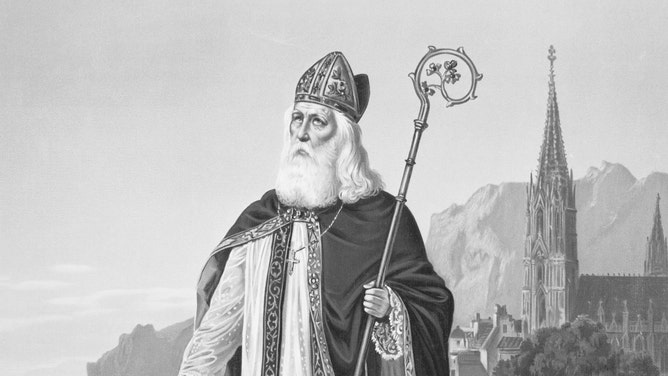
A lithograph of the patron saint of Ireland, St. Patrick.
(Bettmann / Getty Images)
Born in the late 4th-century Britain, Patrick became associated with nearby Ireland, primarily through his work to bring Christianity to the Green Isle.
Patrick's introduction to Ireland, however, occurred under brutal circumstances. He was kidnapped from his home at the age of 16 and brought to Ireland as a slave. He then spent six years working for a master before escaping and returning to Britain.
Legend has it that while he was back home, Patrick had dreams of the Irish people, who were Celtic pagans at the time, crying and begging him to return to Ireland to "save their souls," said Stack.
Patrick, who had become a priest after his enslavement, did indeed return to Ireland and began converting the Irish into Christians.
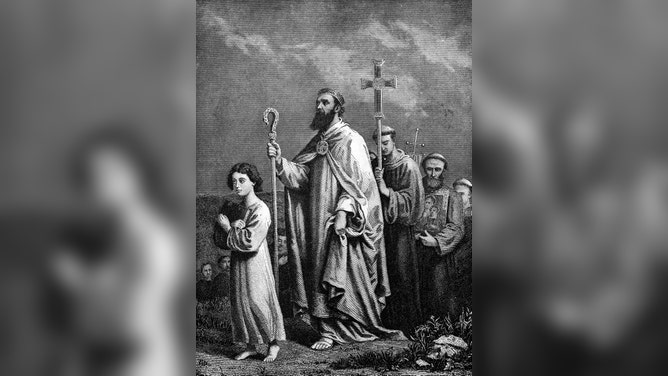
Engraving of St. Patrick traveling to the Hill of Tara in Ireland.
(Bettmann / Getty Images)
One of the most notable people Patrick converted was the high king of Ireland. According to Stack, Patrick used the shamrock to illustrate the holy trinity to the king, with the three shamrock leaves representing the Father, Son and the Holy Spirit.
Because of this, the shamrock has been associated with St. Patrick.
THE TRUE STORY BEHIND SHAMROCKS AND OTHER IRISH SYMBOLS
Patrick is also associated with driving snakes out of Ireland. According to Stack, however, this is merely a symbol of his driving out paganism and not actual snakes.
Patrick continued his mission for years until his death in A.D. 461 on March 17.
What is the history of St. Patrick's Day?
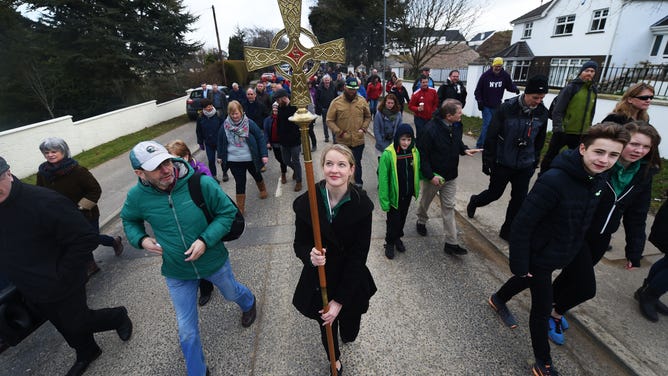
Church goers take turns in carrying a staff representing Saint Patrick during the annual Saint Patrick's Day service and pilgrimage from Saul church to Downpatrick cathedral on March 17, 2016 in Downpatrick, Northern Ireland. St. Patrick is believed to be buried at Saul church.
(Charles McQuillan / Getty Images)
In the centuries that followed, the day of St. Patrick’s passing became a holiday or "feast day" in the Christian calendar.
"It would have been what's called a holy day of obligation," Stack said, adding there would have been mass on St. Patrick's Day, a tradition that is still alive today in Ireland.
WHAT TYPES OF WEATHER IRELAND SEES ON ST. PATRICK'S DAY
She noted that the holy day was also tied to Lent, a 40-day period of fasting leading up to Easter. Falling in the middle of this fasting period, St. Patrick's was a day when fast could be broken in Ireland, Stack said.
St. Patrick’s Day was largely quiet when businesses closed, and parents stayed home with their families.
The holiday, however, later began to sprout off from the traditional Irish celebrations and incorporate new traditions across the Atlantic Ocean.
How St. Patrick's Day was brought to America

Irish Emigrants Leaving Home, the Priest's Blessing, Ireland, 18th century.
(Sepia Times / Universal Images Group / Getty Images)
In the 18th and 19th centuries, St. Patrick’s Day traditions were brought to North America by way of Irish immigrants. While in this new land, the holiday experienced an evolution.
Perhaps one of the most significant changes to the quiet, contemplative holiday was the rise of more spirited celebrations – specifically, the St. Patrick's Day parade.
The parade began in New York in 1762 with Irish members of the British Army, according to Stack.
HOW BATTLE REENACTMENTS BRING MILITARY AND WEATHER HISTORY TO LIFE
"This is pre-Revolution, and it was an opportunity for them at the time to commiserate and memorialize their homelands," she said.
Stack noted that many of the Irish people were conflicted when they were fighting for the British Army during the American Revolution, as they were fighting for their own independence from the British at the same time.
The St. Patrick's Day parade gains significance
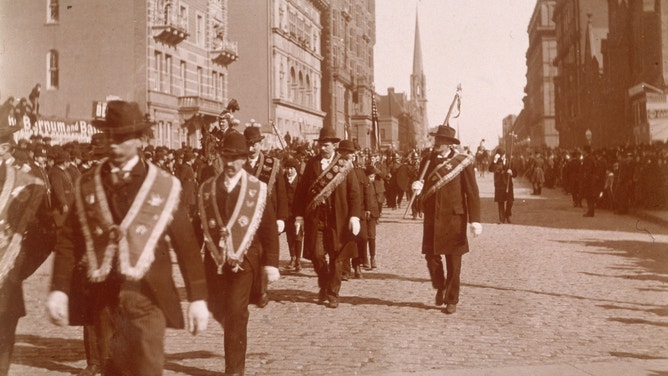
Men march in the Saint Patrick's Day Parade, wearing Irish sashes and carrying banners, in midtown Manhattan, New York City in 1895.
(Museum of the City of New York / Byron Collection / Getty Images)
Then in the 19th century, after the U.S. became an independent nation, Irish immigrants began arriving to its shores.
Many of the immigrants came to escape the Great Hunger and other waves of famines in Ireland. In doing so, they brought along their traditions, such as St. Patrick’s Day.
Much like the Irish members of the military decades earlier, Irish Americans in New York City began incorporating the parade in their St. Patrick's Day celebrations.
IRISH STEP DANCING WITH THE IONA UNIVERSITY DANCE TEAM
But unlike their military forebears, Stack said Irish Americans hosted the parade to showcase Irish immigrants’ contributions to American society.
"You had parades of men who were policemen and in the Army and the Navy and sanitation marching up Fifth Avenue," Stack said. "It was a demonstration of their voting power as an immigrant group, but also it showed their willingness to serve and to be part of the fabric of American political and city life."
How St. Patrick's Day evolved in America
Apart from politics, St. Patrick’s Day parades and other forms of celebration in the U.S. helped Irish Americans think of their homeland while in their new home.
"It was a great way of connecting for those who had never visited Ireland, but knew they were of Irish heritage," Stack said.
While many aspects of St. Patrick’s Day allowed Irish immigrants and their descendants the chance to remember Ireland, it also gave way to new traditions for Irish Americans.
Some of those changes involved food. For example, while corned beef and cabbage are considered a traditional Irish meal, it is not eaten in the same way in the motherland.

A plate of corned beef and cabbage, set on a shamrock-patterned tablecloth.
(Whitney Hayward / Portland Press Herald / Getty Images)
"We [in Ireland] would eat bacon and cabbage, but it was difficult to get bacon allegedly here in the 19th century," Stack said. "A lot of the butchers in some of the cities were Jewish people, so they wouldn't handle pig."
She added that corned beef was a very cheap, cured meat, which was ideal for working-class immigrants living in tenements in the city. Because of its low cost, corned beef along with cabbage took hold in America.
Other St. Patrick’s Day traditions well-known in the U.S. aren’t reflected in Ireland.
Stack said rivers in Ireland aren't dyed green for the occasion, and neither is a popular beverage usually consumed on St. Patrick's Day in America.
"We don't really drink the beer green," Stack laughed. "I think Irish people would kill you for adulterating their beer with food coloring."
Everybody is Irish
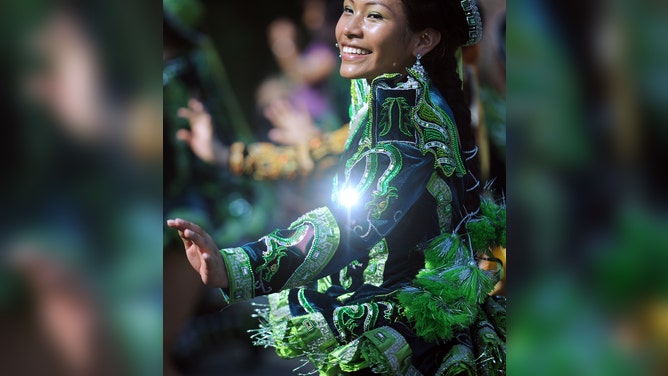
A woman dances with her Bolivian dance group while participating in the 12th annual St. Patrick's Day Parade in Gaithersburg, MD.
(Astrid Riecken / The Washington Post / Getty Images)
St. Patrick’s Day has undergone a number of transformations since the days of the patron saint more than 1500 years ago.
One of those transformations is the growing popularity of the holiday, the traditions celebrated by people of all backgrounds.
"On St. Patrick's Day, everybody is Irish," Stack said.
